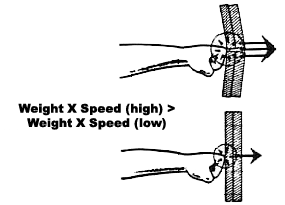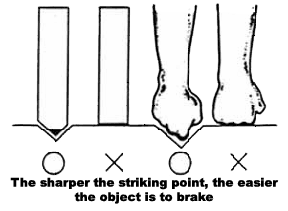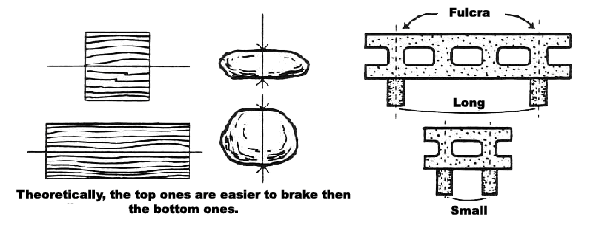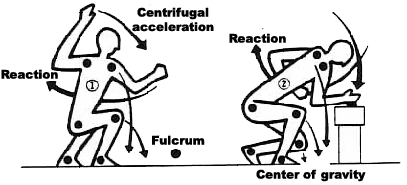

Tameshiwari, the art of breaking wood, title, bricks, and stone with the first or the bare foot, is not a purpose of karate, but rather serves as a barometer of acquired strength and technique. It is useful for this purpose because in Kumite (sparring) you must never actually touch the opponent for fear of causing extreme physical injury.
Tameshiwari allows the karateka to expend total effort and energy on an inanimate object, and successful results are indicative of one who had mastered his art.
Tameshiwari requires exceptional balance, form, concentration of spirit, and calmness. It is a challenge to the ability of the karateka and will test the limits of his strength, He must use all the power he possesses in order to succeed at each attempt.
THE DYNAMICS OF TAMESHIWARI
 1. Materials
1. Materials
Used
A wooden board will always fracture along its grain. Therefore, the shorter the length of the wood grain, the easier it is to break. On the other hand, tiles, bricks, and cinder blocks are all synthetically manufactured and are therefore more homogeneous and lack lines of weakness. Due to this fact, these materials generally present a greater challenge to the karateka.
Probably the most difficult material for use in Tameshiwari is natural rock. The denser and more compact the rock, the more difficult it will be to break (In general, the darker-colored rocks are the ones to avoid). The beginner should only attempt to break rocks that are long and thin and exhibit planes of weakness.
 2. Body Contact Areas
2. Body Contact Areas
It is of primary importance that the striking portion of the body be as small and sharp as possible, This provides the object with the least amount of surface are to resist. Obviously when we say that that the striking portion of the body must be small, we do not refer strictly to size as we would be unable to break hard objects with our little finger, which is weak. Therefore, the striking part must be strong and powerful.
Obviously, human flesh and bone can never be as strong as rock or concrete and this is where technique and spiritual preparation enter the picture.
 3. Power and Striking Angle
3. Power and Striking Angle
The strength necessary for the successful performance of Tameshiwari is achieved by marshalling (arranging) all of the body's reserves. Especially important is power generated up through the legs.
There are two ways to increase your power when performing Tameshiwari. The first is to take advantage of acceleration due to gravity. To understand this, think of this example: if a man weighting 154 lbs. (70 kgs.) stands on one foot, the earth receives a force of 154 lbs. (70kgs.). However, if he jumps up and then hits the earth with one foot, the force will be greater than 154 lbs. (70 kgs.) due to the acceleration caused by the gravitational pull. This force can be increased even further by bending and stretching the hips while in the air.
The second method for maximizing the power of a blow is to strike the object perpendicularly; in other words there should be an angle of 90 degree between the arm and the object. If the object is struck form any other angle, the force of the blow is spread over the surface of the object rather than pinpointed.
4. Speed
The two most important things in Tameshiwari are power and speed. Speed is dependent upon many things including muscular strength, flexibility, bending and stretching of the hips, and quick reflexes. These can be acquired only through training. Once the karateka has mastered all the spiritual and physical requirements, all that is left for him to do is constant practice.
5. Methods
As illustrated below, there are three possible methods for breaking an object. The first method, showing the object simply resting on two supports, is the most difficult and therefore least preferred. The next two methods are much superior, In both, a solid base such as the anvil pictured is used as a support. One end of the object rests directly on the top of the palm which rests on a folded towel on the anvil. The difference between the two is in the positioning of the object.

In one method, the end rests directly on the anvil and you strike the object as shown by the arrow. In the other method, one-third (1/3) of the object hangs over the edge of the anvil and it is struck at the point shown by the arrow. In each case, before striking the object is lifted by the supporting hand a finger's width off the anvil as shown. If you wish, you may cover the object completely with a towel or cloth in order to avoid injury to your hand. It may appear that the last method is more difficult because you must strike the object directly above a support point, actually the sharp edge of the anvil aids in cracking the object.

Although the last two methods are very efficient for breaking one tile, they are not effective for breaking many tiles because of you inability to lift that much weight with on hand. The karateka must therefore use the first method, which is more difficult, because it lacks the additional breaking force acquired by the lifting of the object.
The Four Dynamics of Breaking
1. Proper Form and Tension
2. Focus / Concentration
3. Proper breathing, Nogare and Ibuki
4. Follow Through
Osu!

